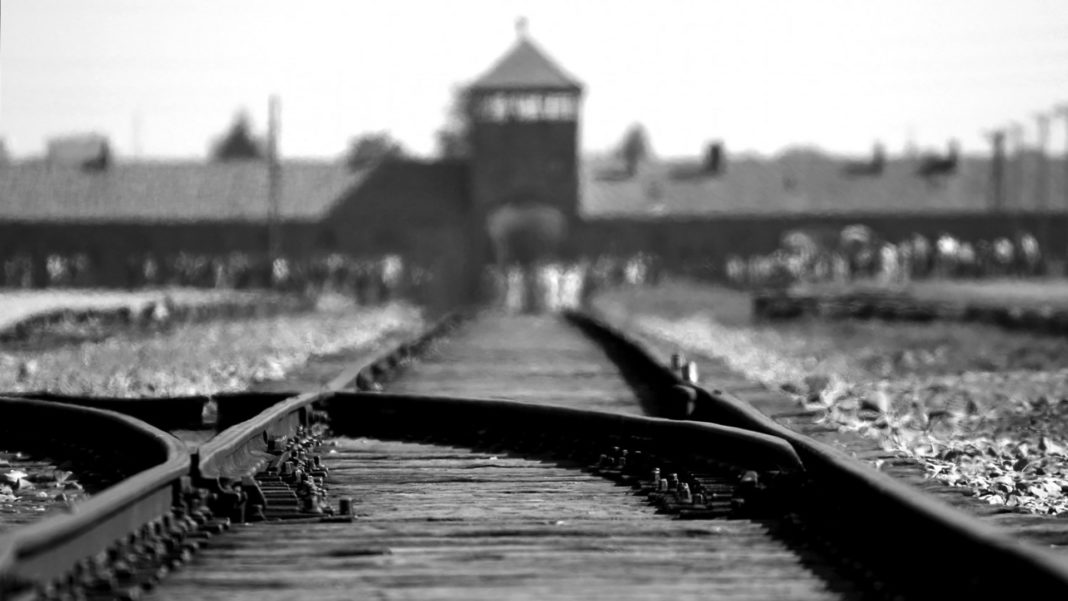“No one may dare alter the truths of the Holocaust, no matter how noble his motives.” By Donal O’Keeffe.
Boy did John Boyne get his answer.
On Twitter earlier this month, the Irish author most famous for his schmaltzy 2006 international bestseller, The Boy in the Striped Pyjamas, and the 2008 movie which adapted it, had a pop at the literary cottage industry of recent fictional works with the word ‘Auschwitz’ in their title.
“I can’t help but feel that by constantly using the same three words, & then inserting a noun, publishers & writers are effectively building a genre that sells well, when in reality the subject matter, & their titles, should be treated with a little more thought & consideration,” Boyne wrote.
His tweet (which has since been deleted) included a photograph of several such novels.
The Child of Auschwitz. The Sisters of Auschwitz. The Brothers of Auschwitz. The Mistress of Auschwitz. The Librarian of Auschwitz. The Saboteur of Auschwitz.
Also included was Heather Morris’ The Tattooist of Auschwitz, which topped the Irish bestseller charts in 2018 and 2019.
Someone calling themselves Lisbon Lion (@tirnaog09) helpfully tagged the Auschwitz Museum in Poland into their reply to Boyne, saying “The @AuschwitzMuseum is quick to point out the many factual errors in such books. Great care is needed to ensure the memory of the Holocaust isn’t in any way diminished by this developing genre.”
And here, to paraphrase Art Spiegelman’s genuinely important Holocaust graphic novel Maus, John Boyne’s troubles began.
The Auschwitz-Birkenau Holocaust Memorial Museum (@AuschwitzMuseum) responded: “We understand those concerns, and we already addressed inaccuracies in some books published. However, The Boy in the Striped Pyjamas should be avoided by anyone who studies or teaches about the history of the Holocaust”.
The research centre, located at the former Nazi death camp in Poland, linked to their tweet an article by Hannah May Randall warning readers away from Boyne’s novel, which it criticises as historically inaccurate. Boyne refused to read the article, which appears on an educational site run by the Holocaust Survivors’ Friendship Association, because, he said, it contained three inaccuracies in its first paragraph. As a Twitter storm developed, and Boyne was excoriated by other users, it was argued that none of the stated inaccuracies were, in fact, inaccurate.
The Boy in the Striped Pyjamas tells the fictional story of the friendship, across the Auschwitz fence, between two children, nine-year-old German boy Bruno, whose father is a Nazi commandant, and Jewish boy Shmuel, who is a prisoner in what Bruno calls Out-With.
SPOILER ALERT: Crawling under the (apparently non-electrified) fence, Bruno sneaks into the camp, dresses in prison clothing, and dies in the gas chamber. His devastated father apparently repents his sins, allowing himself to be captured by Allied forces. Because, although a million-and-a-half children were slaughtered by the Nazis, God love the poor little fictional German boy.
Bruno is presented as oblivious of his surroundings. As Randall writes in her essay, “Bruno is nine years old but doesn’t seem to be aware of the war around him, who the Jews are or even who Adolf Hitler is. As a young German boy, and the son of a senior SS officer, Bruno would have been, by law, a member of the Hitler Youth. He would have attended a German school where students regularly swore oaths to Hitler and where antisemitic propaganda infiltrated every part of the curriculum. Children were taught that the war was something to be proud of as it meant that Germany would become a great power once more.”
Boyne’s presentation of Bruno as an innocent, Randall contends, helps to perpetuate the myth that German people didn’t know about the persecution of Jews, while in fact it was public knowledge throughout Germany and occupied Europe. The systematic genocide of Jews was impossible to ignore, with many Germans profiting from the “Aryanisation” of Jewish properties, stolen from their Jewish owners and “gifted” to ‘ethnic Germans’.

Shmuel is presented, as Randall puts it, as a one-dimensional victim, devoid of personality and individuality, and passive and unresisting to Nazi atrocities. Randall points out that this plays to another dangerous Holocaust stereotype, Jewish non-resistance: “Jewish resistance did exist both in and outside the concentration and death camps.” At Auschwitz-Birkenau a Sonderkommando (Jewish prisoners forced to herd people into the gas chambers and dispose of their bodies) successfully blew up one of the crematoria and killed several guards.
“It is important that people understand that Jewish people did not go to their deaths without trying to save themselves.”
In the wake of the controversy, Boyne told the Irish Times “The novel is subtitled ‘a Fable’. It is a work of fiction with a moral at the centre. I’m not saying that these characters existed, that this story ever happened… I have created a fictional universe populated with fictional characters…
“My point of view is that a novel cannot have inaccuracies because it’s all made up to begin with. What it can have are anachronisms and I don’t think there are any of those in my books.”
It’s hard to know where to begin with that. Nobody is saying the author is claiming his novel is a true story, but many people do think it is, and if you’re going to mess around with the Holocaust then the very least you should do is the bare minimum of research.
The figure of Shmuel, passing his days sitting by the fence, and able to meet Bruno for regular play-dates is more than just a sleight of fiction, more than an anachronism, it is an invention which is offensive in its historical illiteracy.
As Rabbi Benjamin Blech puts it in his devastating essay This well-meaning book ends up distorting the Holocaust: “There were no nine-year-old Jewish boys in Auschwitz — the Nazis immediately gassed those not old enough to work”.
While this omits the Familienlager (family camp), a very specific and exceptional phenomenon in late 1942 / early 1943 whereby a small number of family groups were kept alive for a few months before gassing, generally speaking Blech is overwhelmingly correct: Mothers and children, and the old and infirm went straight from the ‘ramp’ to their deaths.
Randall says some children were kept alive for medical experimentation in Auschwitz, but they were hardly free to shoot the breeze through the fence (which, by the way, was electrified).
Dr Helen Finch, associate professor in German Studies at the University of Leeds, told the Irish Times: “Writers can write what they want, but in my view, you have to reflect on … the accuracy of what you’re writing… If you treat it as an Arthurian romance, material that you can rewrite to your own pleasure, you’re opening yourself to criticism.”
The fact remains that many who have read Boyne’s book think it tells a true story. While this is clearly not the author’s fault, it is sobering to note that 75% of respondents to a 2009 London Jewish Cultural Centre survey believed it was based on a true story.
Worse, many respondents believed “the tragic death of Bruno brought about the end of concentration camps”.
Pawel Sawicki, press officer and educator at the Auschwitz Memorial, told Patrick Freyne of the Irish Times, “[We] meet visitors who come to the Auschwitz memorial and they see the villa of the commandant and say, ‘Oh this is the villa from The Boy in the Striped Pyjamas’ and then we have to explain that, no, the story in The Boy in the Striped Pyjamas, from our historical perspective, couldn’t take place.”
There is something undoubtedly obscene about applying to the Holocaust the cheap “Oh isn’t that awful” thrill of mass-marketed novels which you can close with satisfaction before returning to your life.
Rabbi Blech, who says he set out with every intention of loving The Boy in the Striped Pyjamas, gave the book to a survivor.
“My Auschwitz friend read the book at my urging. He wept, and begged me tell everyone that this book is not just a lie and not just a fairytale, but a profanation. No one may dare alter the truths of the Holocaust, no matter how noble his motives.
“The Holocaust is simply too grim a subject for Grimm fairytales.”
This week marks the 75th anniversary of the liberation of Auschwitz. Instead of reading pablum like Boyne’s novel, or any of the cost-free, surface-wallow The Fill-in-the-Blank of Auschwitz rubbish, now is the time to watch Claude Lanzmann’s landmark 1985 documentary Shoah.
Available on YouTube, it painstakingly and without sentimentality charts the machinery of genocide. It’s nine hours in length, but don’t forget that if we were to give a minute’s silence to every victim of the Holocaust, every Jew, every Roma, every LGBT person, every disabled person, everyone who stood up to the Nazis, then this good Earth would fall quiet for 12 whole years.
At the very least, the dead deserve honesty and rigour in our remembrance.








